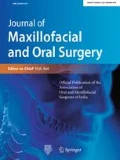Abstract
Pain plagues daily activity and hence its management would require alleviation at both the mental and physical planes, thus, bringing about comfort. It includes delivering analgesics in parenteral or oral form, or patches depending on the intensity and availability. Best analgesic regimens are ones that offer broad coverage, easy to administer, safe and economical. A drug seemingly appropriate to treat moderate to severe pain would be Tramadol hydrochloride, a centrally acting synthetic opioid analgesic with lower opiate-like dependence than Morphine. Ketorolac, a pyrrolo-pyrrole derivative, possesses analgesic, anti-inflammatory and anti-pyretic activity would also appear equally suitable. Fifty adult ASA grade I and II patients undergoing surgery under GA in the Department of Oral & Maxillofacial Surgery, College of Dental Sciences, Davangere, were included. Ketorolac (30 mg IM) for 25 patients and Tramadol (100 mg IM) for 25 patients were administered at the time of skin closure and repeated after 8 and 16 h from the conclusion of surgery. Pain, using the VAS at the 2nd, 4th, 6th, 12th and 24th post-operative hour, was assessed and compared using χ2-test. Vitals were monitored and adverse events were looked for. Though both the drugs resulted in significant decrease in pain intensity from the 2nd to 24th post-operative hour, Tramadol always resulted in better pain control than Ketorolac at every post-operative hour (P < 0.050). To conclude, intramuscular Tramadol seemed useful in controlling pain following surgery, with better levels of tolerance than intramuscular Ketorolac. However, both the drugs produced mild side effects but did not appear to influence the outcome.






Similar content being viewed by others
Reference
Chaturvedi S, Chaturvedi A (2007) Postoperative pain and its management. Indian J Crit Care Med 11(4):204–211
Albino L, Vizzardi M, Letizia G, Martorana U, Sanfilippo A, Osti L, Cervelli C, Coluccia R (1998) Intramuscular tramadol versus ketorolac in patients with orthopedic and traumatologic postoperative pain: a comparative multicenter trial. Curr Ther Res 59(1):39–47
Colletti V, Carner M, Vincenzi A, Dallari S, Mira E, Benazzo M, Cosentino G, Bellussi L, Passali D (1998) Intramuscular tramadol versus ketorolac in the treatment of pain following nasal surgery: a controlled multicenter trial. Curr Ther Res 59(9):608–618
Tripathi KD (2003) Essentials of medical pharmacology, 5th edn. Jaypee brothers Medical Publishers, New Delhi
Satoskar RS, Bhandarkar SD, Ainapure SS (2001) Pharmacology and pharmacotherapeutics, 17th edn. Popular Prakashan, Mumbai
MHRA Drug Safety Update October 2007, 1(3):3–4
Altunkaya H, Ozer Y, Kargi E, Babuccu O (2003) Comparison of local anaesthetic effects of tramadol with prilocaine for minor surgical procedures. Br J Anaesth 90:320–322
Altunkaya H, Ozer Y, Kargi E, Ozkocak I, Hosnuter M, Demirel CB, Babuccu O (2004) The postoperative analgesic effect of tramadol when used as subcutaneous local anesthetic. Anesth Analg 99:1461–1464
Scott LJ, Perry CM (2000) Tramadol: a review of its use in peri-operative pain. Drugs 60:139
Joel GH, Lee EL (2001) Goodman & Gillman’s the pharmacological basis of therapeutics, 10th edn. McGraw-Hill Medical Publishing, New York
Loach A (ed) (1994) The management of postoperative pain in orthopedic anesthesia, 2nd edn. Edward Arnold, London, p 65
Donald RM (2002) The efficacy of combination analgesic therapy in relieving dental pain. JADA 133:861–871
Melzack R, Katz J (2006) Pain assessment in adult patients. In: McMohan SB, Kaltzenburg M (eds) Wall and Melzack’s textbook of pain, 5th edn. Elsevier Churchill Livingstone, Philadelphia, p 292
Vickers MD, O’flaherty D, Szekely SM, Read M, Yoshizumi J (1992) Tramadol: pain relief by an opioid without depression of respiration. Anesthesia 47:291–296
Lehmann KA (1994) Tramadol for the management of acute pain. Drugs 47(Suppl 1):19–32
Strom BL, Berlin JA, Kinman JL et al (1996) Parenteral ketorolac and risk of gastrointestinal and operative site bleeding: a post-marketing surveillance study. JAMA 275:376–378
Cossmann M, Kohnen C (1995) General tolerability and adverse event profile of tramadol hydrochloride. Rev Contemp Pharmacother 6:513–553
Zackova M, Taddei S, Calo P, Bellocchio A, Zanello M (2001) Ketorolac versus tramadol in treatment of postoperative pain during maxillofacial surgery. Minerva Anestesiol 67:641–646
Author information
Authors and Affiliations
Corresponding author
Rights and permissions
About this article
Cite this article
Shankariah, M., Mishra, M. & Kamath, R.A.D. Tramadol Versus Ketorolac in the Treatment of Postoperative Pain Following Maxillofacial Surgery. J. Maxillofac. Oral Surg. 11, 264–270 (2012). https://doi.org/10.1007/s12663-011-0321-y
Received:
Accepted:
Published:
Issue Date:
DOI: https://doi.org/10.1007/s12663-011-0321-y




